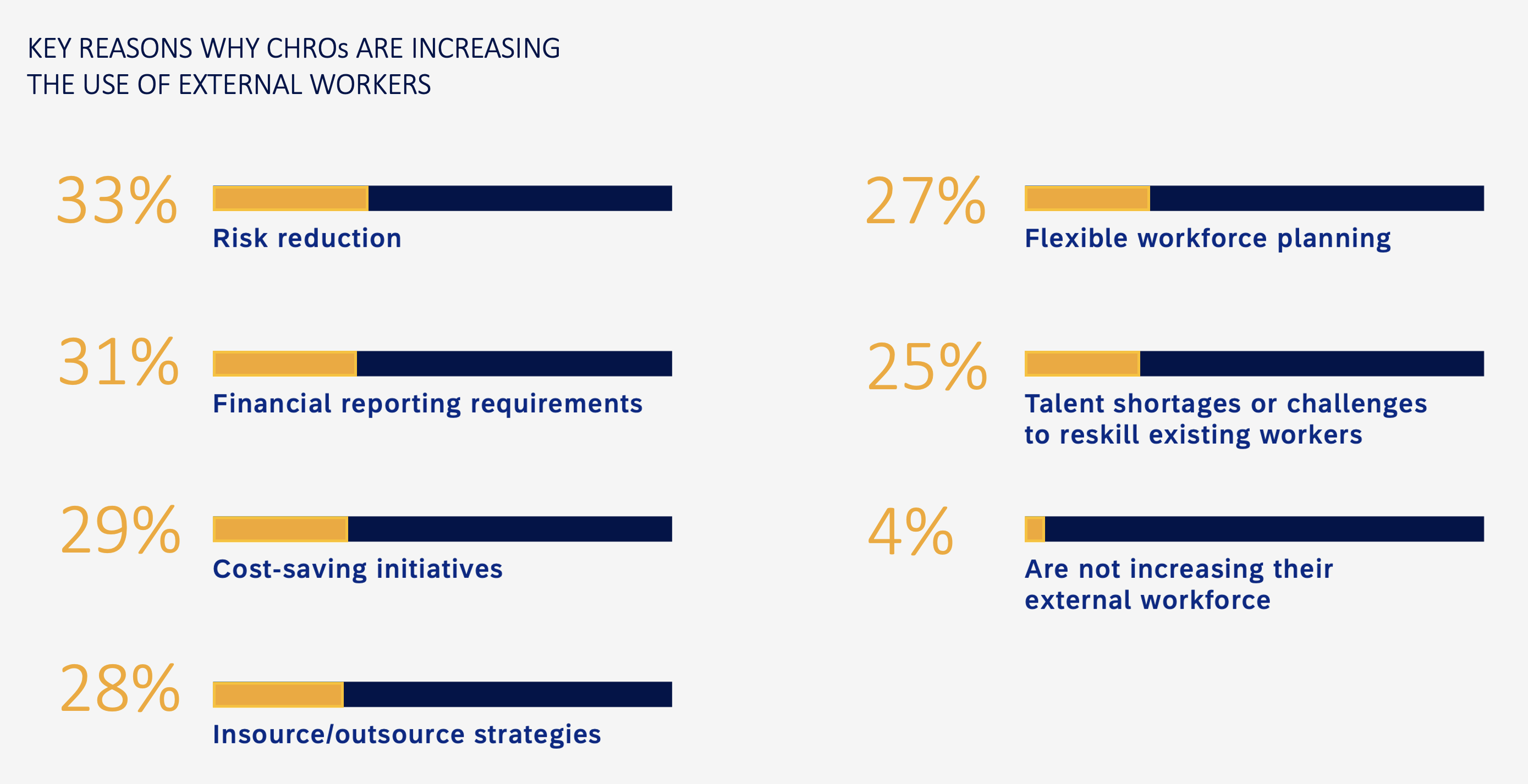Four Questions HR Should Be Asking About Non-Payroll Workers
The competitive importance of non-payroll workers
As we navigate ongoing global uncertainty, companies are questioning their operating models. Digital transformation is both driving and mediating this trend, and it’s enabling big changes in the way we think about how to find, retain, and leverage talent.
One of the most significant of these changes is the increased use of non-payroll workers. Many companies now look to them as a source of the skills they need
to stay competitive, gain flexibility, and reduce costs. This is especially true as global talent markets remain tight, which means addressing every need with a full- time hire isn’t always possible or practical – making non-payroll labor a better option.
We can refer to these workers as the “external workforce.”
Who makes up the external workforce?
- Contingent labor: this generally refers to temporary workers or freelancers sourced by your organization or staffing partners.
- Service labor: this typically includes freelancers, service workers, consultants, and contractors sourced by service providers, such as ad agencies, consulting, and construction firms.
External workers are now much more than simply temps or contractors. They take on critical roles in organizations and influence everything from product design to expanding into new markets to brand reputation. And they’re set to continue growing as a share of the total workforce in the next few years:
- 50% of C-suite executives say they plan to increase their use of the external workforce.
- 55.7% of surveyed organizations expect skills gaps in their labor market to limit the transformation of their business.
4 KEY QUESTIONS FOR HR
- Are you adopting a total workforce management strategy mindset?
- How much visibility do you have of your external workforce?
- Can you effectively mitigate risks related to your contingent workers and service providers?
- How closely do you collaborate with procurement and other stakeholders to manage your external workforce?
Why external workers are gaining ground

One in four (27%) CHROs say that flexible workforce planning is a key reason their organization is increasing the use of external workers. A quarter (25%) cite talent shortages or the challenges involved in reskilling their existing workforce. These are understandable positions as uncertainty continues to complicate strategic planning, flexibility becomes more important to embrace changes to local and global marketplaces, and talent and skills gaps are still at the top of the HR agenda.
Higher demand for – and reliance on – external workers can create challenges for HR, such as the need to comply with constantly changing labor regulations, meet security guidelines, and maintain visibility and control across a wide range of processes and metrics. But new sources of vital skills also bring value and opportunities to scale your growth and make strategic pivots easier.
92%
of organizations need to adopt new workplace strategies to stay competitive
This paper explores four key questions designed to help HR leaders and teams optimize external workforce management, making it easier to win the race for talent and stay competitive. These questions – along with related insights and strategies – are informed by findings from a recent Economist Impact survey of 500 C-suite executives, which examines how organizations are responding to changing business environments and tight labor markets.

Question 1: Are you adopting a total workforce management strategy mindset?
Nearly half (47%) of CHROs said “balancing internal and external workers” will be their priority as they work to deliver increased value to the organization. What’s more, 28% said “insource or outsource strategies” are a key reason for increasing their external workforce. But effectively deploying these approaches requires a total workforce management approach that some organizations may not be ready to implement.
HR leaders will already be more than familiar with the challenges inherent in keeping track of employee data across disconnected systems. These challenges only escalate when you’re also trying to manage growing numbers of external workers – who often require use of their own solutions and rules.
Right now, you may have good control over the financial aspects of managing contingent workers and service providers (contracts, POs, and payments). But if you’re like most other companies, you’ll be falling short when looking at these resources from a talent perspective. This means you may not fully understand the skills and capabilities available across your entire organization.
Why adopt a total workforce management strategy?
Visibility: Create one view of all workers – internal and external – that underpins important operational capabilities.
Actionable insights: Tailor metrics for employees and external workers to meet business needs.
Optimized workforce: Make sure that the right people with the right skills are working on each task – and working their best.
Trackable credentials: Help guarantee that employees and external workers have the necessary training and certifications.
Increased employee and external worker engagement: Boost productivity and bottom-line business impact.
But with a single view of both internal and external workers, you’ll be able to undertake more informed and precise workforce planning, fill roles faster, and close skills gaps. You can also adapt more quickly to new business strategy, strengthen productivity, and improve your organization’s bottom line. And all of this is critical given that most companies now face labor shortages.
A total workforce management strategy enables your vendor management and HR systems to work together to create a consistent strategy and experience for your entire workforce – covering planning, staffing, onboarding, and payment. In addition, you’ll get the tools to manage everything from training to global compliance for your entire team. The result? A dynamic, flexible workforce ready to adapt almost in an instant, so every part of your business has the right resources to keep moving forward.
A holistic, integrated approach to workforce planning delivers centralized visibility and control across your entire workforce.
This gives teams the power to quickly see available resources, address skills gaps, and make informed decisions about when to use internal and external workers according to a consistent strategy.
Question 2: How much visibility do you have of your external workforce?
Ask yourself this: how much do you know about your external workers?
- Who are they?
- What are they working on?
- When did they start, and when will they finish?
- Where are they located?
- How much are you paying them? Are rates competitive?
- What access do they have to your systems, confidential data, and facilities?
- What is their quality of work?
HR executives are recognizing the need for greater visibility into everyone working on their company’s behalf – not just employees, but also contingent workers and service providers. If you can answer the above questions about your external workers, you’ll be much better prepared to use them strategically and efficiently.
Almost half (43%) of CHROs say that increased visibility of all workers will help them deliver greater organizational value in the future. Other C-suite executives agree, with over 40% saying that increased visibility is a priority.
43%
of CHROs say increased visibility of the total workforce is a top priority to deliver greater value to the organization

If your organization has comprehensive people and skills data for employees and the external workforce, you can more easily connect your external workers to other business-critical roles and assignments, enabling you to bring a proper skills mix to every part of your business.
In today’s tight labor market, this kind of agility and flexibility delivers a valuable competitive advantage. The faster you’re able to prioritize, source, and redeploy skills to meet demands across your business, the faster you’ll be able to respond to change, launch new products, and take advantage of emerging opportunities.
But companies often face challenges with visibility of their external workers, leaving them undermanaged and either underutilized or overworked as a result.
Why? Because they lack the technology, resources, and insight they need to measure performance, match skills to tasks, and align people to demand.
What could this mean for your business? Besides missing chances to redeploy talent where it’s needed, you might also face increased exposure to a range of quality, compliance, and safety risks – especially when your external workers have access to sensitive data, valuable assets, or secure facilities.
Question 3: Can you effectively mitigate risks related to your contingent workers and service providers?
One-third (33%) of CHROs say the top reason that their organization is increasing the use of an external workforce is to reduce risk. This is also the top reason for their C-suite peers.
The irony is that without actively managing the external workforce, you create risk for your organization. Actively managing your external workforce can help you to reduce or eliminate it.
You also need ways to carefully manage access to systems, confidential information, and facilities based on “need to know” principles. But while you likely have a thorough offboarding process for employees leaving your payroll, your external workers may not be held to the same standard.
Active management helps your people revoke access at the end of an engagement to prevent bad actors from taking advantage of lingering permissions. Digital security threats bring unwanted risk and liability – and potentially undesirable headlines. In fact, CHROs cited cybersecurity issues (such as data breaches, malware, and ransomware) as the top organizational risk priority. Your external workers could pose a major source of risk in these areas, and managing them effectively is key to reducing it.
What’s active management? It means going beyond the simple financial aspects of engagements with outside workers – for example, by making sure that:
- Everyone is classified properly, to avert compliance and payroll tax issues.
- You consistently adhere to local labor and tax laws.
- Your workers have the proper credentials and training to reduce any health, life, and safety risks they encounter on the job.
- You can realize the full value of each engagement by closely managing and tracking work quality and flagging workers who should or shouldn’t be invited back after their engagement ends.
Question 4: How closely do you collaborate with procurement and other stakeholders to manage your external workforce?
Whether HR or procurement takes the lead in your organization’s external workforce strategy, these two functions must collaborate more closely and effectively to drive results and capitalize on each other’s strengths.
HR brings expertise in both workforce planning and hiring and managing employees. Procurement’s expertise is in sourcing goods and services, contracting, driving efficiencies, and reducing spend. These are complementary skillsets that should be combined to optimize external workforce management. But many companies lack the technology to help the two work together more effectively.
Nearly a third (32%) of CHROs said that direct sourcing of contractorwill be a priority in helping deliver increased value to the organization, while 28% cited talent networks. This further underscores the importance of access to the right external workers to support your organization. Procurement’s expertise plays a key role in these areas, and digital solutions bring real value as well.
Who’s responsible for external workforce strategy?
- 42% of C-suite executives said HR is responsible, and 30% said procurement is responsible.
- 52% of CHROs said HR is responsible, and only 20% said procurement is responsible.
But collaboration on the external workforce shouldn’t be limited to procurement and HR alone. You’ll also need to engage your lines of business (LOBs), since they work with external workers day to day and know details such as how well they’re performing and when they’re completing assignments and should be offboarded. Their insights are also critical to inform strategy, helping you decide how you’ll insource and outsource key skills and capabilities to support LOB goals and those of the whole organization.
To enable cross-functional collaboration, procurement, HR, and LOB stakeholders need to be working from the same data. A centralized management system makes it easy for everyone involved to engage effectively when and where needed.
Solutions to help you win the race
It takes all kinds of workers to keep your business going and growing – from full- and part-time employees to service providers and contingent staff. If you rely on manual processes or siloed systems and departments to manage different parts of your workforce, you’ll often be left without a clear view of your overall team.
And as external workers become increasingly critical for business resilience, the ability to manage them effectively can significantly impact your competitive success.
Digital cloud solutions from SAP can help, enabling you to:
- Source, engage, manage, and pay your contingent workers and service providers with exceptional speed and efficiency.
- Close accountability gaps, avoid compliance issues, and control access to sensitive information and physical environments.
- Develop an effective total workforce management strategy.
- Gain end-to-end visibility and control over every aspect of your external workforce.
- Mitigate organizational risk through automated oversight.
- Collaborate closely with procurement and other key departments to advance your organizational objectives.
29%
of CHROs say that external workforce management is a main driver for digital transformation in procurement.
And a third of procurement leaders (31%) cite external workforce management as a top driver for digital transformation within procurement.
Transform external workforce results with SAP

Total Workforce Management Strategy
Establish a clear, cohesive view of your entire workforce and proactively manage everyone – employees and external workers – with a total workforce management strategy driven by integrated SAP® Fieldglass® applications and SAP SuccessFactors® solutions. Meet the dynamic needs of your business and close critical skills gaps quickly and efficiently through centralized support for recruitment and onboarding through to performance, compensation, learning, development, and succession.
Discover how Standard Chartered Bank applied a future-ready solution
SAP Fieldglass Services Procurement Application
Rapidly add and effectively manage external workers. Gain visibility and control over the people-related aspects of the services you buy to maximize value, control costs, support efficient processes, and minimize risks.
SAP Fieldglass Contingent Workforce Management Application
Quickly and efficiently find, engage, and manage nonpayroll workers to deliver the right talent at the right time across different parts of your business while gaining visibility into value and staying compliant with labor regulations.
Find out how Yamaha achieved 100% adoption two months after the go-live event
SAP Fieldglass Worker Profile Management Application
More effectively manage your complete population of nonpayroll workers – even those not tied to a job posting or statement of work in your vendor management system.
See original post by SAP
